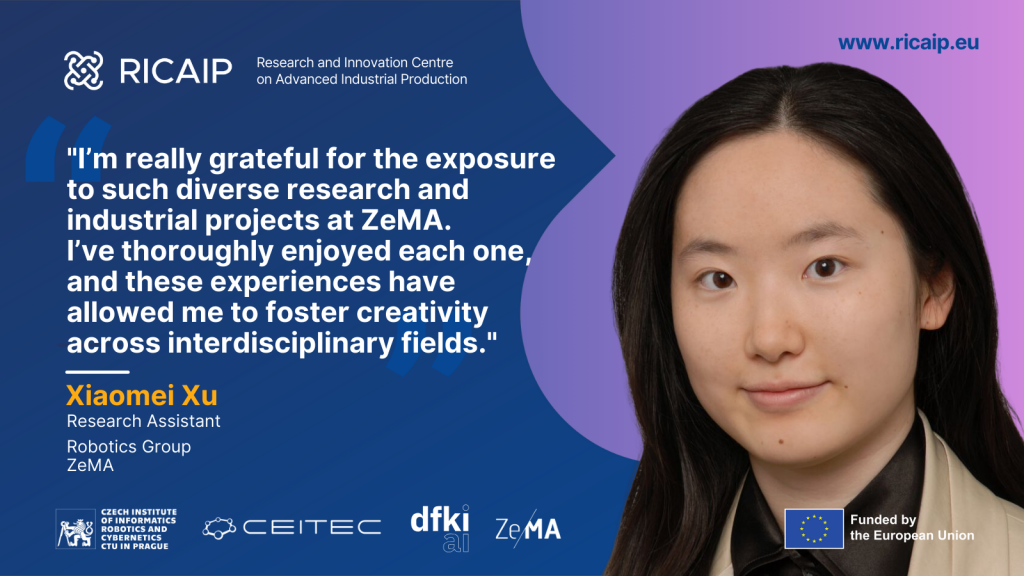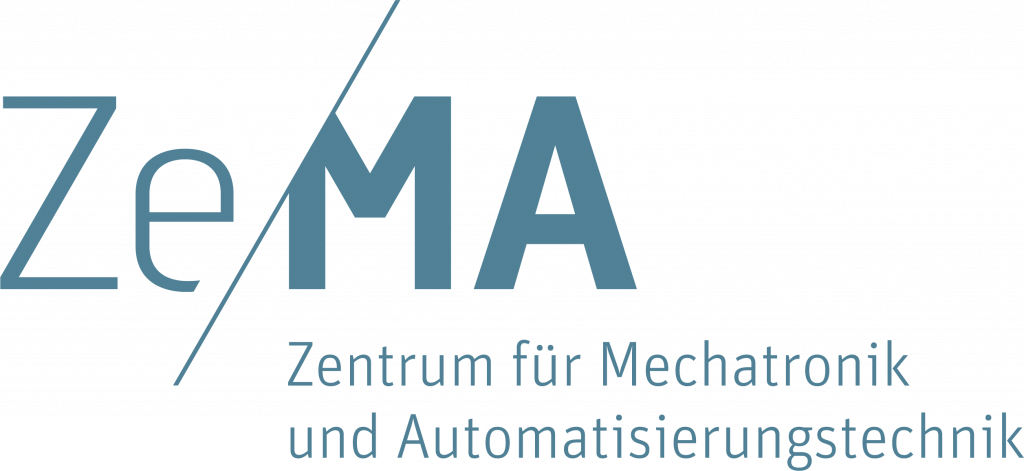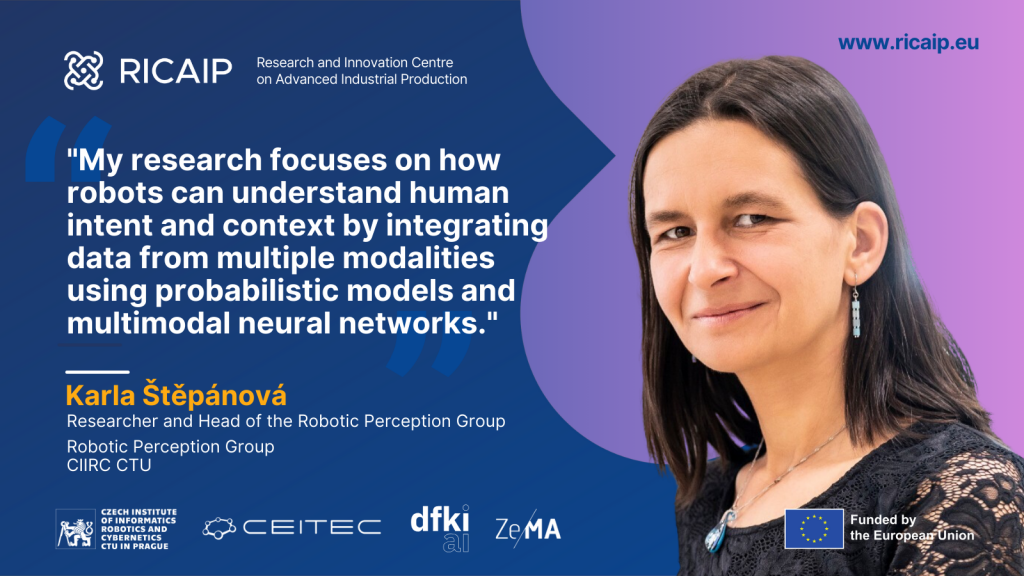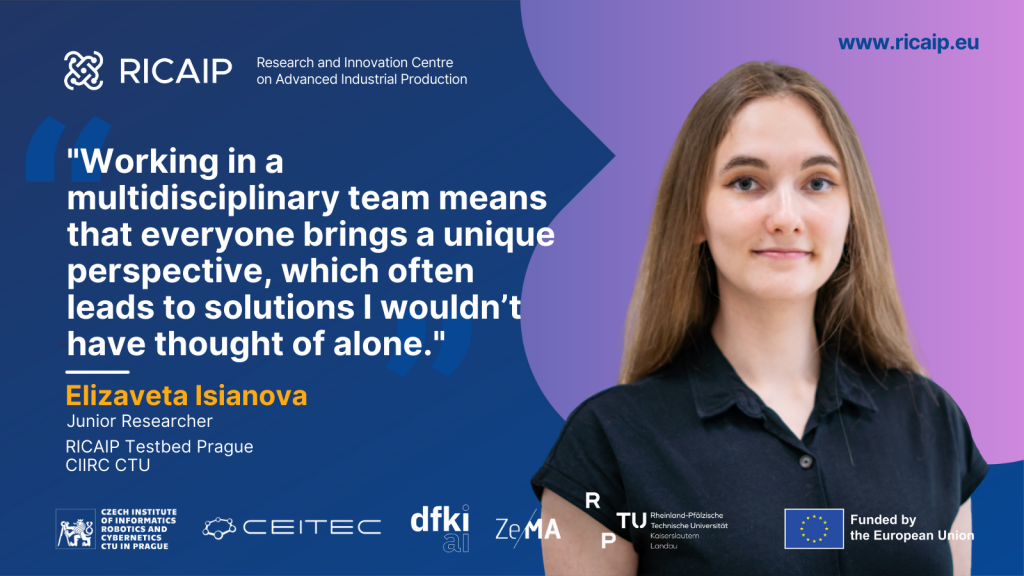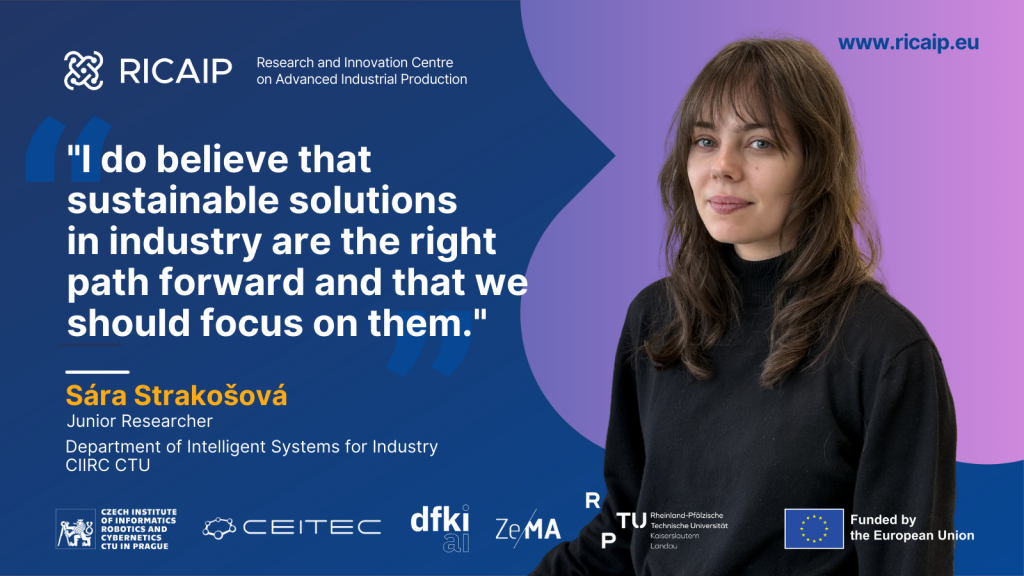At RICAIP, we’re proud to celebrate the International Day of Women and Girls in Science, recognized by the United Nations on February 11. Science thrives on diverse perspectives, and we’re lucky to have talented women in our teams contributing to exciting research and innovation. This year, we’re introducing three inspiring researchers, each with a unique story and expertise. Whether they are part of our teams, involved in synergistic projects, or directly engaged in RICAIP initiatives, their stories deserve to be heard. Get to know Khansa and Xiaomei from ZeMA, and Karla from CIIRC CTU.
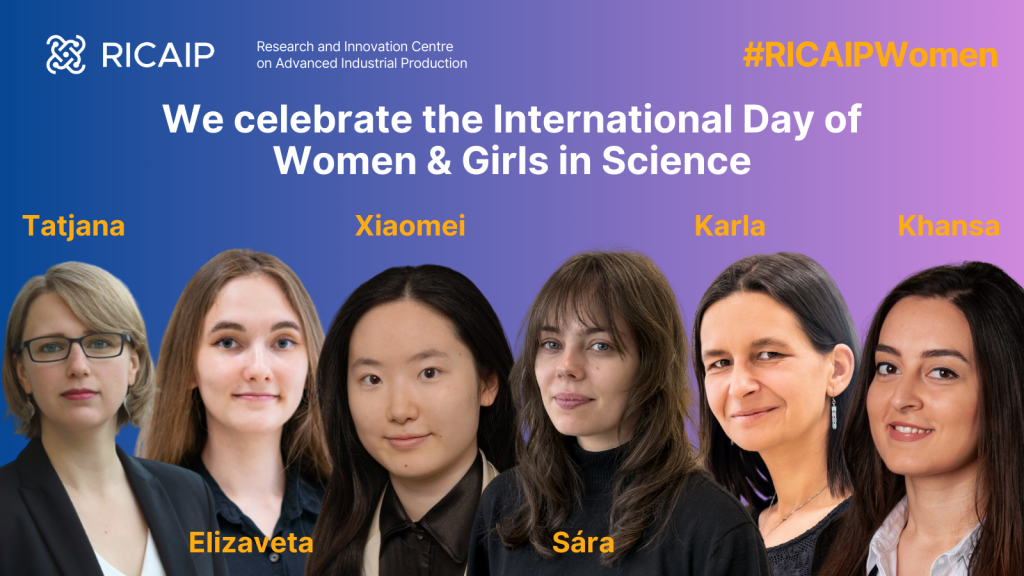
Bio
I have been a research assistant in the Robotics group at the ZeMA Center for Mechatronics and Automation Technology since April 2020. I graduated with a master’s degree in automation technology from RWTH Aachen University in 2019, where I completed my master’s thesis on the iCellFactory project at the WZL Machine Tool Laboratory.
My specialization lies in developing adaptive frameworks for collision-free trajectory planning, using Siemens Robot Export and OMPL. During my internships, I worked at the Research Center Jülich and the VW Academy Hannover. Since April 2020, I’ve been involved in the Robotix Academy Project, where I’ve been developing an intelligent tangram puzzle system using industrial robots. Since July 2022, I’ve also been working on the RICAIP project, focusing on object recognition and 3D pose estimation for industrial parts in the Bin Picking challenge. Additionally, my research includes improving CAD reconstruction for precise product scans and developing robotic arms to sand burrs on ceramic products.
What are you currently working on and what nearest prospects do you see for your work?
Throughout 2024, I worked on four projects and published papers in CRIP CATS 2024, IEEE CASE 2024, CRIP ICME 2024, and CRIP CMS 2025. In the RICAIP project, I developed a sorting system for Raspberry Pi covers and integrated it into the DFKI multi-agent system with the MiR100 robot. In the EDIH project, I contributed to developing an operational assistant system that uses a robotic arm to assist doctors during surgeries. In SenRob2.0, I created a highly accurate surface detection system for ceramic product burrs. In the MDZ project, I built an AI demo to compete with visitors in playing Super Mario.
I’m really grateful for the exposure to such diverse research and industrial projects at ZeMA. I’ve thoroughly enjoyed each one, and these experiences have allowed me to foster creativity across interdisciplinary fields. They also give me the daily satisfaction of overcoming challenges and pushing the boundaries of what’s possible.
What has recently intrigued or inspired you in your field/domain?
Beginning with actual industrial needs, we aim to enhance the robustness and stability of existing mathematical methods for industrial applications. My ongoing efforts are dedicated to achieving meaningful and groundbreaking innovation. If I can be so lucky as to stay in the assembly automation industry, I hope to use every second of my time to break through a little bit more in the field of artificial intelligence and industrial robotics.
When faced with a work-related challenge, where do you seek advice, and how do you approach resolving it? What strategies work best for you?
I’m enjoying my current job so much that every day feels like it’s flying by. I am eternally grateful to Prof. Müller, current group leader Attique Bashir, and former group leader Ali Kanso for their encouragement and guidance, as well as to my colleagues who have helped me. Their kindness and strong sense of conviction have always kept me grounded. Despite the uncertainties of the future, I have always believed in my abilities.
Bio
I am a researcher at the Czech Institute of Informatics, Robotics, and Cybernetics at CTU in Prague (CIIRC CTU) and the head of the Robotic Perception Group. My work focuses on developing AI-driven systems that enable robots to learn from human instructions and demonstrations. I am particularly interested in how robots can understand human intent and context by integrating data from multiple modalities using probabilistic models and multimodal neural networks.
I have been leading the Robotic Perception Group since 2024. I earned my Ph.D. in Artificial Intelligence and Biocybernetics from the Faculty of Electrical Engineering at CTU in Prague in 2017 and my Master’s degree in Condensed Matter Physics from the Faculty of Mathematics and Physics at Charles University in 2010.
My research interests include probabilistic models of cognition, unsupervised learning, multimodal integration, language acquisition, symbol grounding, learning by demonstration, and human-robot interaction.
What are you currently working on and what nearest prospects do you see for your work?
Currently, I am mainly focusing on how we can communicate with robots both verbally and nonverbally and how robots can understand the tasks we want them to perform. We aim to model this communication both by a deep multimodal neural network as well as by a more analytical, probabilistic approach that integrates information from language, gestures, and the observed scene.
Since these signals are temporal and asynchronous, aligning them requires specialized algorithms capable of handling the challenge of limited data. Additionally, we consider the context of the situation—such as object properties and user profiles—when interpreting instructions.
What has recently intrigued or inspired you in your field/domain?
This year, we will be starting a major European project that will connect robotics with large multimodal models. While my experience with large models is still quite limited, I am thrilled about the opportunity to work with top research teams in this dynamic and exciting field, and to apply it to a robotics use case. I’m also really looking forward to our ongoing collaboration with the start-up RoboTwin—a start-up founded by the inspiring girl, Megi Mejdrechova, who has also conducted research with us and was selected this year by Forbes Česko for its 30 Under 30 list.
When faced with a work-related challenge, where do you seek advice, and how do you approach resolving it? What strategies work best for you?
I love planning, organizing, and tackling complex problems. Sometimes I get overwhelmed, but most of the time, I enjoy solving them. I often simplify complex problem-solving to a multi-criterion constrained optimization problem with random variables—both in science and in personal life. Taking a snapshot of the current world and my beliefs about the constraints I face, I try to find the optimal decision.
Bio
I am Khansa Rekik, a researcher and project leader at the Assembly systems department in ZeMA. Along with my current work at ZeMA, I am currently pursuing my PhD degree in the field of AI &Human-Robot collaboration. I have a masters degree in Industrial informatics and Robotics, and a master degree in Computer Science. During and after my studies I had the opportunity of working with international entities in research in France and Germany as well as in an multinational industrial manufacturing company.
What are you currently working on and what nearest prospects do you see for your work?
Although Human-Robot Collaboration is not a new technology, its use in manufacturing is still very limited. With the philosophy of applied research that my department has, my work aims at bridging some of the gaps between fundamental research and industrial challenges. More specifically, it sheds light on how such technology can be integrated in practical industrial applications as well as how robots can act as a reliable partner in these collaborative scenarios, in terms of autonomous perception, safety and decision making. I believe that through the close interaction our institution has with industry and through the variety of projects we are exposed to, some of the results of our research stand a big chance of inspiring companies.
What has recently intrigued or inspired you in your field/domain?
In a field with such a fast pace, one gets inspired quite often. Amongst a long list, I can mention “multi-modality in Human-Robot collaboration” namely models that collect different types of data from both robot tasks/demonstrations and the web, then uses the generalized knowledge to control robots. These models show enhanced capabilities in visual and semantic understanding in tasks they were not exposed to.
When faced with a work-related challenge, where do you seek advice, and how do you approach resolving it? What strategies work best for you?
Depending on the type of challenge I face, the strategies might vary. However, I believe I am the communicative type. If the challenge is related to an exact scientific matter or technology, I seek advice from individuals from the field, likely those who have more experience or knowledge. If it is a “creative” matter, I ask people around me, not only people from my field, because, in some cases people from similar backgrounds may approach challenges similarly. By asking them, I am usually not looking for an answer, I am more looking for perspectives that might not occur to me, and it is often very fruitful.
Bio
I am a junior researcher at the Czech Institute of Informatics, Robotics, and Cybernetics at CTU in Prague (CIIRC CTU), where I work at the Testbed for Industry 4.0. I recently graduated with a Master’s degree in Robotics and Cybernetics from the Faculty of Electrical Engineering at CTU.
What are you currently working on and what nearest prospects do you see for your work?
During my time at CIIRC, I have been working on different projects focusing on software development for robotic projects on human-robot collaboration, intelligent automation, and 5G networked systems. Currently, I work in a team that works on robotic perception, pose estimation, and 3D reconstruction. My current research focuses on integrating multimodal foundational models into robotic grasping and I plan to continue developing this field.
What has recently intrigued or inspired you in your field/domain?
The pace at which multimodal foundation models have been evolving over the past few years is truly exciting. It is fascinating to see how these models are bringing us closer to more natural and intuitive human-robot interaction. The idea that robots could soon perceive and respond to the world in a way that feels more natural is something that drives my passion for this field.
When faced with a work-related challenge, where do you seek advice, and how do you approach resolving it? What strategies work best for you?
When facing a challenge, I first turn to my colleagues. Working in a multidisciplinary team means that everyone brings a unique perspective, which often leads to solutions I wouldn’t have thought of alone. A quick discussion or brainstorming session can go a long way in breaking down a problem.
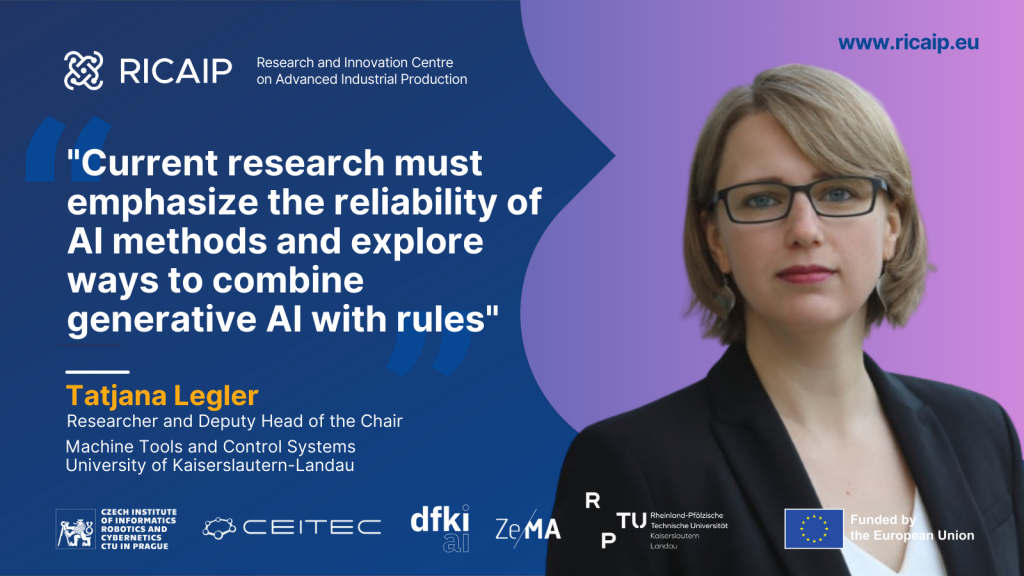
Tatjana Legler
Researcher and Deputy Head of the Chair
Machine Tools and Control Systems
University of Kaiserslautern-Landau

Bio
I am a researcher and deputy head of the chair of Machine Tools and Control Systems at the University of Kaiserslautern-Landau.I studied mechanical engineering with a specialization in production technology, and I am currently pursuing my PhD to see how AI can be integrated with production technology.
What are you currently working on and what nearest prospects do you see for your work?
My main research area is federated learning, a decentralized machine learning paradigm that enables multiple clients to collaboratively train a global model without sharing raw data. This approach allows different companies to work together without disclosing their sensitive data. As a result, it is not necessary to train a new model from scratch every time, and our research has shown that these models are even more robust and better at generalizing than conventional models.
What has recently intrigued or inspired you in your field/domain?
In context of AI, a lot has happened in recent years, especially in the realm of LLMs and generative AI. In addition to GPT models, videos can now be entirely generated by AI—a development that was unthinkable just a few years ago. However, it is important to distinguish hype from reality. Particularly in manufacturing, high prediction accuracy is essential and hallucinations must be avoided—an accuracy of 95% simply isn’t sufficient. Current research must emphasize the reliability of AI methods and explore ways to combine generative AI with rules (e.g., Retrieval-Augmented Generation).
When faced with a work-related challenge, where do you seek advice, and how do you approach resolving it? What strategies work best for you?
When faced with a work-related challenge, it depends on the problem. For more complex issues, I find it helps to take some quiet time to focus on the problem and think through potential solutions. On the other hand, when I need a quick perspective, talking to my colleagues can also be incredibly helpful. This mix of reflection and collaboration allows me to approach problems from different angles and find the best course of action for resolving them.
Bio
I am a junior researcher at the Czech Institute of Informatics, Robotics, and Cybernetics (CIIRC) at CTU, where I work in the Department of Intelligent Systems for Industry. I graduated from the Faculty of Mechanical Engineering in 2022 with a Master’s degree in Mechatronics and am now pursuing my PhD in the field of flexible automation solutions.
What are you currently working on and what nearest prospects do you see for your work?
I am currently working on my publications that focus on the lifecycle management of EV batteries, particularly end-of-life solutions for secondary applications. My research explores how digital twins of EV batteries can be used to create efficient remanufacturing or recycling processes to enhance sustainability and reduce waste.
What has recently intrigued or inspired you in your field/domain?
I do believe that sustainable solutions in industry are the right path forward and that we should focus on them. I’m inspired by the idea of people and nature finding a better balance, and I believe that even a small step in the right direction can make a difference. In a time when scientifically proven global warming caused by human activity is still met with denial—even among world leaders and academia—it is important to support and implement truly sustainable solutions and drive the transition toward a more circular economy.
When faced with a work-related challenge, where do you seek advice, and how do you approach resolving it? What strategies work best for you?
For me, brainstorming with my colleagues is the most effective approach. I really enjoy working in teams and solving problems together, as different perspectives often lead to innovative solutions.

